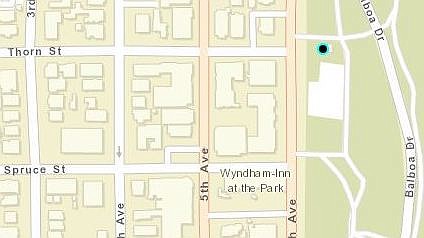 Facebook
Facebook
 X
X
 Instagram
Instagram
 TikTok
TikTok
 Youtube
Youtube

A pair of prefab toilets, bestowed with an Onion award last year for their undistinguished design, are now being recognized as an American Public Works Association project of the year.
The nomination has nothing to do with architectural beauty, but rather, plumbing. The Balboa Park West Mesa Comfort Stations, located at 6th Avenue and Nutmeg, have low flow toilets and lighting that meet the city’s sustainability goals.
They replace two outdated facilities - and there are plenty more. Many of the park's existing comfort stations were built in the 1960s. Today, they aren't exactly comforting.
According to a city report, the 23 toilets in Balboa Park are "among the worst in the city of San Diego Parks system of 191 Comfort Stations.”
While the report focuses on health, safety and ADA compliance, area residents, architects and planning groups dislike the facade. The out of a box toilets "are perfect examples of the worst that happens when the city buys inappropriate and highly visible buildings without professional design services and drops them into historic Balboa Park."

The comfort stations, themselves, have a history. In 2001, the city began looking into using pre-designed buildings for multiple similar structures in the city’s inventory.
Public works later came up with designs for fire stations, shade structures and comfort stations. In 2019, an update to the city's Consultant's Guide to Park Design & Development finally provided new standards, even though the city still lacks a public toilet strategy for fixing or replacing them all.
The two basic styles for comfort stations, which are chosen by Parks and Recreation department staff, are traditional, with separate men’s and women’s restrooms, or an arrangement of gender-neutral stalls and outdoor sinks.
The West Mesa toilets are a unisex design with individual restroom stalls and exterior hand washing sinks. Each station has at least one ADA accessible restroom stall.
"The building design and materials shall harmonize with the design of the park’s theme or natural character."
As some see it, the city has instead prioritized low-bid cost-cutting, creating an aesthetic chaos exemplified by the West Mesa toilets.
"The project will be a blight on the crown jewel of San Diego on the West Mesa for the next 50 years," said Banker's Hill resident, Bruce Dammann, in a comment letter to the city.
It took six years to build and cost twice as much as it should have, Dammann said, arguing that the engineering and capital improvements department, "should never be in charge of the design of projects in our city parks."
The estimated total project cost is $2,378,963, and the budget to date is $716,718. CIP Project Information Detail (sandiego.gov)
An assessment of the condition of the 60s-era comfort stations found it will cost nearly half their replacement value to return them to a serviceable level.


A pair of prefab toilets, bestowed with an Onion award last year for their undistinguished design, are now being recognized as an American Public Works Association project of the year.
The nomination has nothing to do with architectural beauty, but rather, plumbing. The Balboa Park West Mesa Comfort Stations, located at 6th Avenue and Nutmeg, have low flow toilets and lighting that meet the city’s sustainability goals.
They replace two outdated facilities - and there are plenty more. Many of the park's existing comfort stations were built in the 1960s. Today, they aren't exactly comforting.
According to a city report, the 23 toilets in Balboa Park are "among the worst in the city of San Diego Parks system of 191 Comfort Stations.”
While the report focuses on health, safety and ADA compliance, area residents, architects and planning groups dislike the facade. The out of a box toilets "are perfect examples of the worst that happens when the city buys inappropriate and highly visible buildings without professional design services and drops them into historic Balboa Park."

The comfort stations, themselves, have a history. In 2001, the city began looking into using pre-designed buildings for multiple similar structures in the city’s inventory.
Public works later came up with designs for fire stations, shade structures and comfort stations. In 2019, an update to the city's Consultant's Guide to Park Design & Development finally provided new standards, even though the city still lacks a public toilet strategy for fixing or replacing them all.
The two basic styles for comfort stations, which are chosen by Parks and Recreation department staff, are traditional, with separate men’s and women’s restrooms, or an arrangement of gender-neutral stalls and outdoor sinks.
The West Mesa toilets are a unisex design with individual restroom stalls and exterior hand washing sinks. Each station has at least one ADA accessible restroom stall.
"The building design and materials shall harmonize with the design of the park’s theme or natural character."
As some see it, the city has instead prioritized low-bid cost-cutting, creating an aesthetic chaos exemplified by the West Mesa toilets.
"The project will be a blight on the crown jewel of San Diego on the West Mesa for the next 50 years," said Banker's Hill resident, Bruce Dammann, in a comment letter to the city.
It took six years to build and cost twice as much as it should have, Dammann said, arguing that the engineering and capital improvements department, "should never be in charge of the design of projects in our city parks."
The estimated total project cost is $2,378,963, and the budget to date is $716,718. CIP Project Information Detail (sandiego.gov)
An assessment of the condition of the 60s-era comfort stations found it will cost nearly half their replacement value to return them to a serviceable level.
Comments